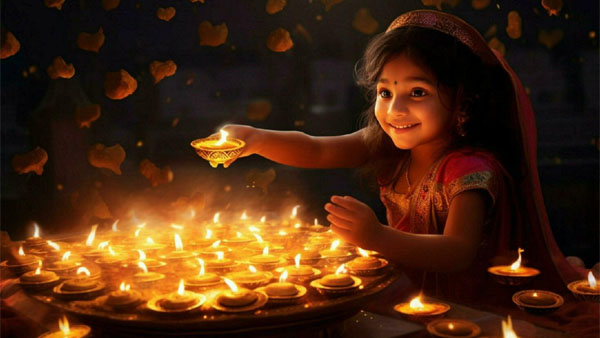By Satyabrat Borah
Religion and spirituality are often used interchangeably in everyday conversations, but they are distinct concepts with unique characteristics, purposes, and impacts on human life. While both offer pathways to meaning, purpose, and connection, their approaches and implications differ significantly. Religion is typically associated with organized systems of beliefs, rituals, and practices, often rooted in specific cultural or societal frameworks. Spirituality, on the other hand, is a more personal, introspective journey that seeks inner peace, self awareness, and a deeper understanding of existence. In this article, we explore the nature of religion and spirituality, their differences, their interplay, and their roles in shaping individual and collective lives, particularly in the context of modern society.
Religion is a structured system that provides a framework for understanding the universe, human existence, and morality. It often includes sacred texts, rituals, institutions, and a set of moral codes that guide adherents. For example, in Christianity, the Bible serves as a foundational text, with practices like attending church, praying, and celebrating festivals such as Christmas forming the core of religious life. Similarly, in Hinduism, texts like the Bhagavad Gita and rituals like puja or festivals like Diwali define the religious experience. Religion is inherently communal, bringing people together under shared beliefs and practices. It fosters a sense of belonging, creates social cohesion, and often serves as a moral compass for communities. Religious institutions, such as temples, mosques, or churches, provide spaces for collective worship and reinforce cultural traditions. Moreover, religion often prescribes specific roles and responsibilities, offering a clear path for individuals to follow in their quest for meaning or salvation.
Spirituality, in contrast, is deeply personal and less bound by external structures. It focuses on an individual’s inner journey to find purpose, peace, and connection with something greater than themselves, whether that be the universe, nature, or their own consciousness. Unlike religion, spirituality does not require adherence to specific doctrines or participation in organized rituals. A spiritual person may find fulfillment in meditating under a tree, contemplating the beauty of a sunset, or practicing mindfulness to connect with their inner self. For instance, someone might feel a profound sense of awe while hiking in the mountains, experiencing a connection to the universe without invoking any religious framework. Spirituality is about exploration and self discovery, often transcending the boundaries of any single belief system. It allows individuals to ask existential questions, such as the purpose of life or the nature of existence, and seek answers in their own way.
One of the most significant differences between religion and spirituality lies in their scope and structure. Religion is often collective, rooted in tradition, and governed by established rules and institutions. It provides a shared identity and a sense of community, but it can also be restrictive, as it may demand conformity to specific practices or beliefs. For example, religious doctrines might dictate how to pray, what to eat, or how to conduct oneself in society. Spirituality, however, is more fluid and individualistic. It does not require allegiance to a particular deity, text, or institution. A spiritual person may draw inspiration from multiple traditions or none at all, focusing instead on personal growth and inner peace. For instance, practices like yoga or mindfulness, which have roots in religious traditions, are often pursued in a spiritual context without requiring adherence to the religious systems from which they originated.
Despite their differences, religion and spirituality are not mutually exclusive and often intersect. For many, religion serves as a gateway to spirituality. Religious practices, such as prayer, meditation, or reading sacred texts, can foster spiritual experiences by encouraging introspection and connection with a higher power. In Hinduism, for example, the practice of yoga is both a religious discipline and a spiritual tool for self realization. Similarly, in Islam, the act of Salah (prayer) is a structured religious obligation that can also lead to a profound spiritual connection with Allah. However, not all religious practitioners experience spirituality, and not all spiritual individuals follow a religion. Some people may diligently perform religious rituals out of habit or social expectation without delving into the deeper spiritual significance, while others may reject organized religion entirely yet pursue a rich spiritual life.
The relationship between religion and spirituality also highlights their respective strengths and limitations. Religion’s strength lies in its ability to create community and provide moral guidance. Festivals like Eid, Christmas, or Durga Puja bring people together, fostering a sense of unity and shared purpose. Religious teachings often emphasize values like compassion, honesty, and charity, which help maintain social order. However, religion can sometimes become rigid, leading to dogmatism or division. History is replete with examples of conflicts fueled by religious differences, from crusades to modern sectarian tensions. Spirituality, by contrast, is less likely to create such divisions because it is inherently personal and inclusive. It emphasizes universal values like love, empathy, and interconnectedness, which transcend cultural or religious boundaries. However, spirituality’s lack of structure can sometimes leave individuals feeling directionless, lacking the clear guidance that religion provides.
In modern society, the distinction between religion and spirituality has become more pronounced, particularly as people increasingly seek individualized paths to meaning. Many individuals, especially in urban and globalized settings, are moving away from strict religious adherence and embracing spirituality as a way to navigate the complexities of modern life. Practices like meditation, mindfulness, and yoga have gained popularity as tools for stress relief and self discovery, often divorced from their religious origins. This shift reflects a growing desire for flexibility and personal freedom in the search for meaning. For example, a young professional in a bustling city might practice mindfulness to cope with stress, finding spiritual fulfillment without affiliating with any religious tradition. At the same time, religion continues to play a vital role for many, offering a sense of identity and community in an increasingly fragmented world.
In the context of Assamese society, both religion and spirituality have deep roots and continue to shape cultural and individual lives. The Vaishnavite tradition, propagated by the revered saint Sankaradeva, emphasizes both religious devotion and spiritual introspection. Practices like Naam (devotional singing) in Namghars (community prayer halls) blend religious rituals with spiritual experiences, fostering a sense of unity and inner peace. Festivals like Bihu, while rooted in cultural and religious traditions, also evoke a spiritual connection to nature and community. In contemporary Assam, many young people are exploring spirituality through practices like yoga or environmental activism, reflecting a global trend toward individualized spiritual paths. Yet, religious festivals and institutions remain central to Assamese identity, illustrating the coexistence of both dimensions.
The interplay between religion and spirituality also raises questions about their relevance in addressing modern challenges. Religion, with its emphasis on community and moral frameworks, can provide stability in times of crisis, such as during natural disasters or social upheavals. It offers a sense of hope and collective strength. Spirituality, meanwhile, equips individuals with tools to navigate personal struggles, such as anxiety, loss, or existential uncertainty. By fostering self awareness and resilience, spirituality can complement religion’s communal support. For instance, someone attending a religious service might find solace in the community, while also using meditation to process personal grief. Together, these dimensions can create a holistic approach to well being.
Ultimately, neither religion nor spirituality is inherently superior; they serve different purposes and cater to different needs. Religion provides structure, community, and a shared moral framework, while spirituality offers freedom, introspection, and a personal connection to the universe. The choice between them or the balance one strikes depends on individual temperament, cultural background, and life circumstances. Some may find fulfillment in the rituals and traditions of religion, while others may seek the unbound exploration of spirituality. Many find a middle path, integrating religious practices with spiritual introspection to create a meaningful life.
Religion and spirituality, while distinct, are interconnected pathways to understanding life’s deeper questions. Religion offers a structured, communal approach to meaning, rooted in tradition and shared beliefs. Spirituality, by contrast, is a personal journey that prioritizes inner peace and self discovery. Both have unique strengths and limitations, and their interplay can enrich human experience. In a world that is increasingly complex and diverse, understanding the differences and synergies between religion and spirituality can help individuals and communities navigate their search for purpose, connection, and peace. By embracing the wisdom of both, we can cultivate a more balanced and fulfilling approach to life.




